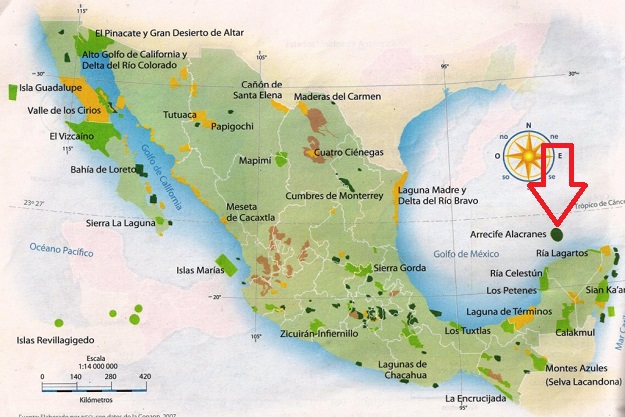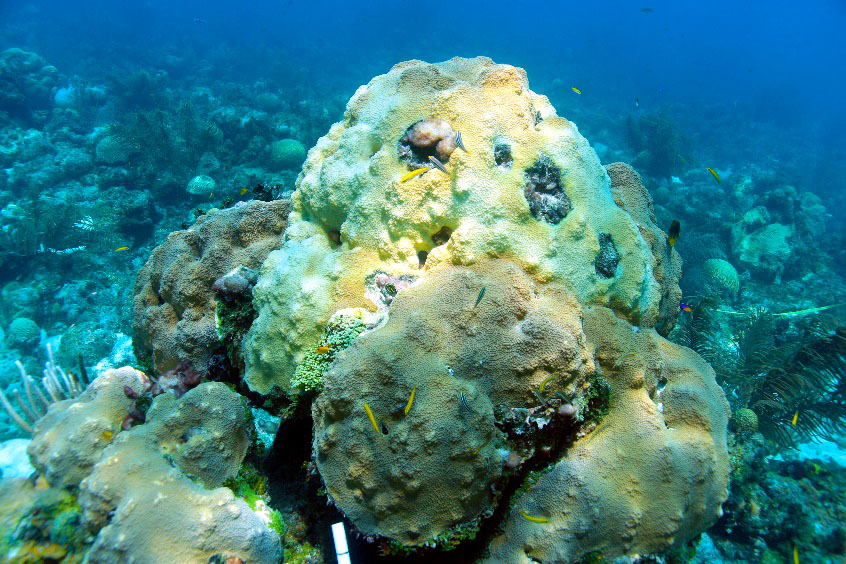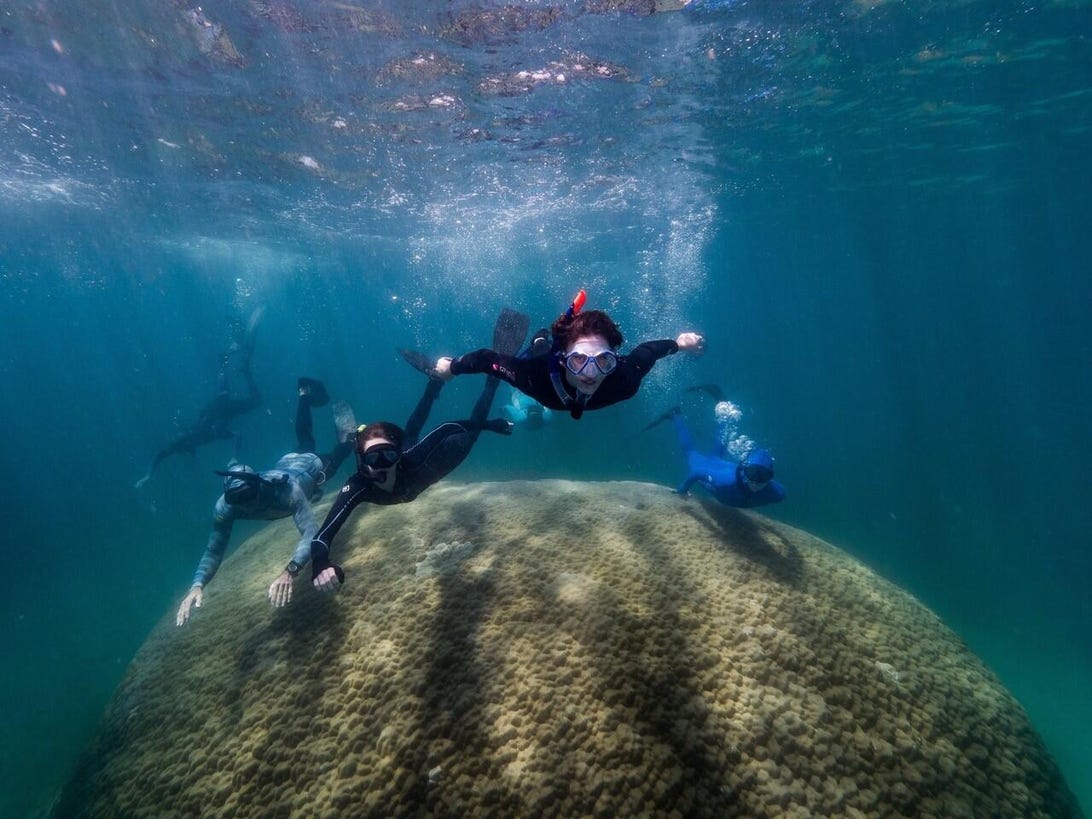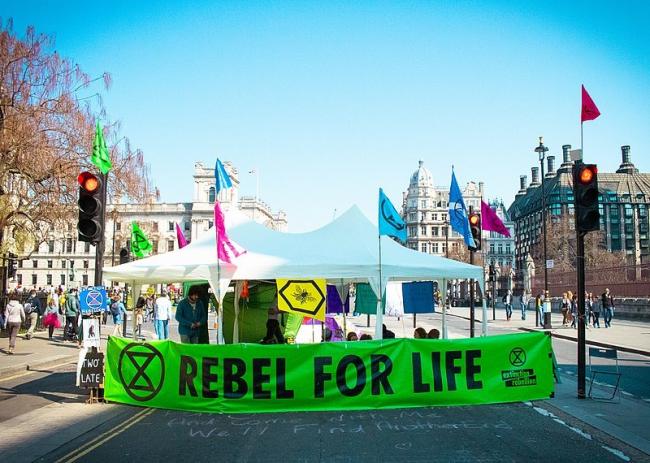By Yucatan Times on August 21, 2021

Photo: (Yucatan ahora)
YUCATAN, (August 21, 2021).- Climate change represents one of the main threats to coral reefs since heat stress events can cause their bleaching (loss of pigment) and with it their massive degradation and subsequent death.
Aarón Israel Muñiz Castillo, doctoral student, and Jesús Ernesto Arias González, researcher at the Department of Marine Resources of the Cinvestav Unit Mérida, evaluated the vulnerability of the corals of the Arrecife Alacranes National Park, located in front of the municipality of Progreso, in Yucatán, before a heat stress event occurred from September to December 2015.

The Alacranes Reef is a group of small islands of coral origin located in the Gulf of Mexico at an approximate distance of 130 km from the coast of Progreso, Yucatán.
Photo: (The Yucatan Times)
In the study published in the journal Marine Pollution Bulletin, it is reported that the bleaching of the corals varied spatially along the Alacranes Reef depending on the depth at which they were located, as well as the vulnerability of each species to increased sea temperature.
The results show that, although an unprecedented heat stress event occurred in the area in 2015, coral bleaching was low (between 10 and 20 percent), which suggests that the corals in this Protected Natural Area have developed some resistance after facing, in the past, the increase in water temperature.
“We not only identified that the accumulated heat stress in the water and the thermal variation in the last 28 days of the analyzed period were the main drivers of coral bleaching, but also the reefs located deeper and those with a complex structure; that is to say, made up of various species, they were more affected ”, explained Arias González, a researcher at the Coral Reef Ecosystem Ecology Laboratory.
Regarding the coral species most susceptible to bleaching, there are those belonging to the genera Agaricia, Orbicella, and Siderastrea; while the damage in those of the Acropora genus was low to moderate.
These data on the response of coral species to bleaching could be useful in generating sensitivity indicators for reefs in other similar areas and in establishing restoration programs and conservation strategies in the face of the increase in global temperature, said Muñiz Castillo, first author of the article.
It is noteworthy that the results obtained, regarding the low percentage of coral bleaching, suggest that the Alacranes Reef is a potential refuge from heat stress events, especially in shallow areas where these organisms have adapted to the constant variations in the increase of the water temperature.
In the study published in the journal Marine Pollution Bulletin, it is reported that the bleaching of the corals varied spatially along the Alacranes Reef depending on the depth at which they were located, as well as the vulnerability of each species to increased sea temperature.
The results show that, although an unprecedented heat stress event occurred in the area in 2015, coral bleaching was low (between 10 and 20 percent), which suggests that the corals in this Protected Natural Area have developed some resistance after facing, in the past, the increase in water temperature.
“We not only identified that the accumulated heat stress in the water and the thermal variation in the last 28 days of the analyzed period were the main drivers of coral bleaching, but also the reefs located deeper and those with a complex structure; that is to say, made up of various species, they were more affected ”, explained Arias González, a researcher at the Coral Reef Ecosystem Ecology Laboratory.
Regarding the coral species most susceptible to bleaching, there are those belonging to the genera Agaricia, Orbicella, and Siderastrea; while the damage in those of the Acropora genus was low to moderate.
These data on the response of coral species to bleaching could be useful in generating sensitivity indicators for reefs in other similar areas and in establishing restoration programs and conservation strategies in the face of the increase in global temperature, said Muñiz Castillo, first author of the article.
It is noteworthy that the results obtained, regarding the low percentage of coral bleaching, suggest that the Alacranes Reef is a potential refuge from heat stress events, especially in shallow areas where these organisms have adapted to the constant variations in the increase of the water temperature.

Photo: (Yucatan ahora)
Because there is a great diversity of microhabitats and reef landscapes in the Arrecife Alacranes National Park, 16 sites were sampled for the study from September to December 2015, a period of high heat stress in the southern Gulf of Mexico.
The coral colonies sampled were counted, measured in their length and height, and the species that made them up were identified. The coral bleaching condition was defined from a visual evaluation considering the categories: normal (completely pigmented), pale (loss of pigmentation but with color retention), bleached (no color), and freshly dead.
The authors of the article took into account 15 indicators as potential drivers of coral bleaching, including different thermal patterns (accumulated heat stress and short-term variation in sea surface temperature, among others); as well as the depth of the location of the corals and the sensitivity of each species.
Arias González and Muñiz Castillo agreed that coral reefs protect coasts and are home to a great diversity of organisms, some of commercial importance such as lobsters, fish, crustaceans, and mollusks, which is why they have an economically relevant role in tourism and fishing.
Hence the need to continue generating assessments within poorly studied areas, especially since the average global temperature for the next 20 years is expected to reach or exceed 1.5 degrees Celsius warming, thereby increasing heat waves and the duration of the warm seasons will be longer; this according to the recent report of the Intergovernmental Panel on Climate Change.
Source: CINVESTAV
The Yucatan Times
Because there is a great diversity of microhabitats and reef landscapes in the Arrecife Alacranes National Park, 16 sites were sampled for the study from September to December 2015, a period of high heat stress in the southern Gulf of Mexico.
The coral colonies sampled were counted, measured in their length and height, and the species that made them up were identified. The coral bleaching condition was defined from a visual evaluation considering the categories: normal (completely pigmented), pale (loss of pigmentation but with color retention), bleached (no color), and freshly dead.
The authors of the article took into account 15 indicators as potential drivers of coral bleaching, including different thermal patterns (accumulated heat stress and short-term variation in sea surface temperature, among others); as well as the depth of the location of the corals and the sensitivity of each species.
Arias González and Muñiz Castillo agreed that coral reefs protect coasts and are home to a great diversity of organisms, some of commercial importance such as lobsters, fish, crustaceans, and mollusks, which is why they have an economically relevant role in tourism and fishing.
Hence the need to continue generating assessments within poorly studied areas, especially since the average global temperature for the next 20 years is expected to reach or exceed 1.5 degrees Celsius warming, thereby increasing heat waves and the duration of the warm seasons will be longer; this according to the recent report of the Intergovernmental Panel on Climate Change.
Source: CINVESTAV
The Yucatan Times

















